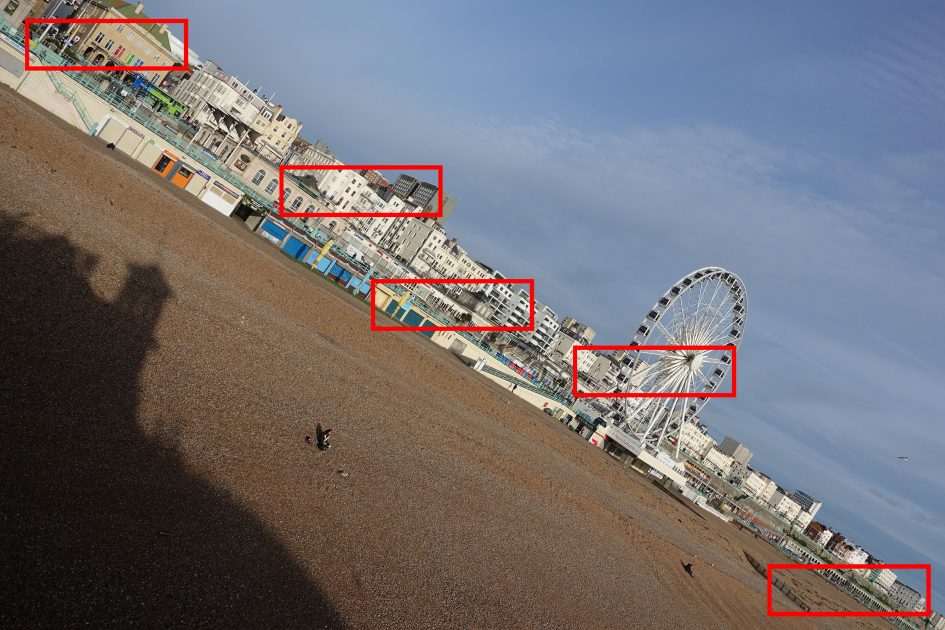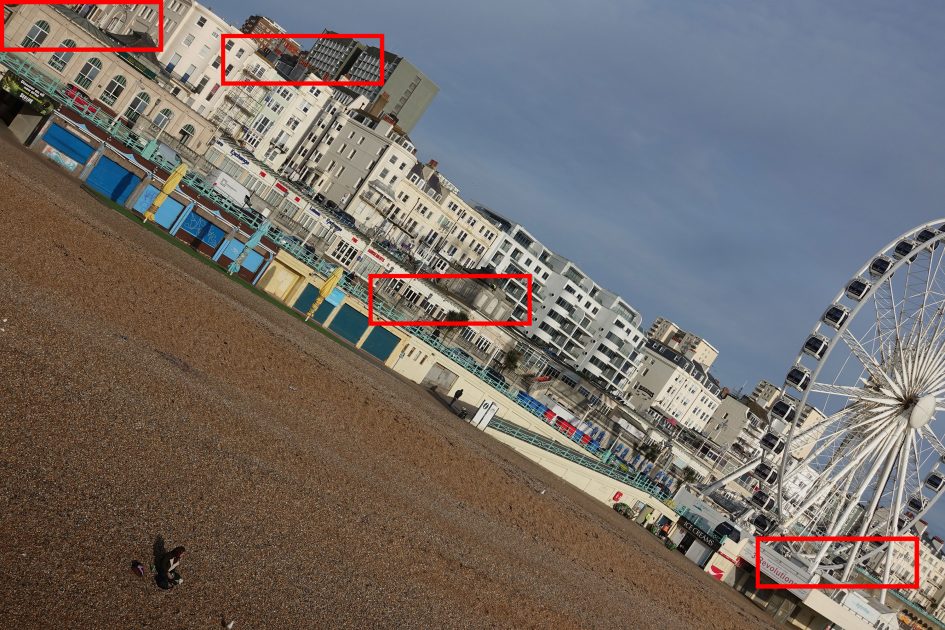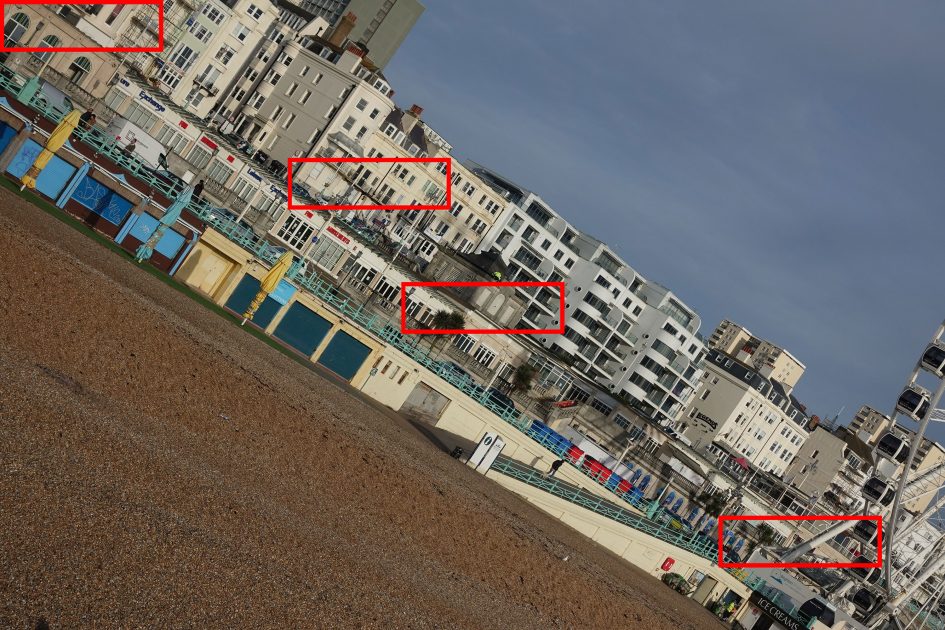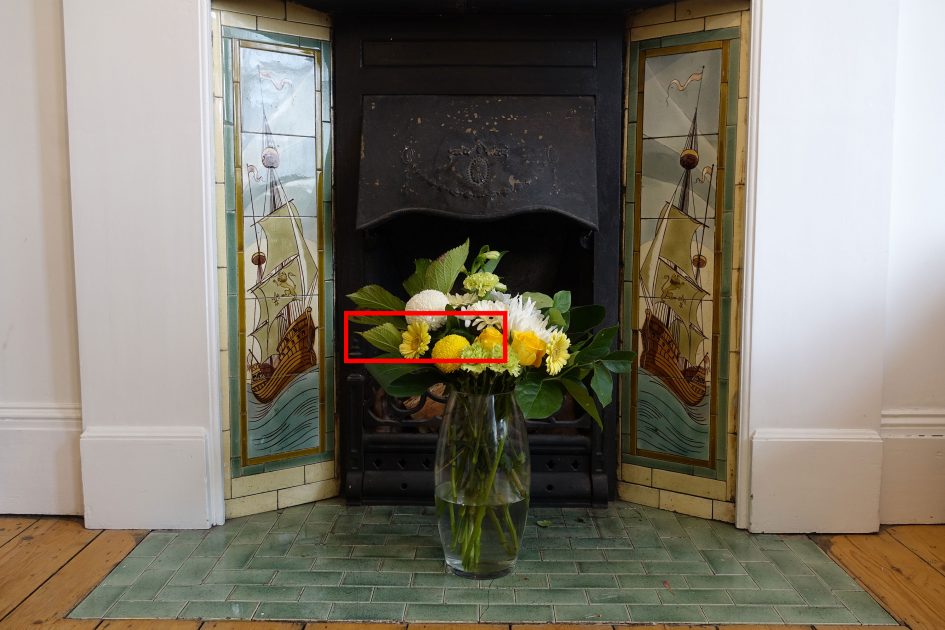Sony RX100 IV review
-
-
Written by Gordon Laing
Quality
Sony’s Cyber-shot RX100 IV shares the same lens as its predecessor, so optically its performance is known. But behind the lens lies a new sensor, and even though the resolution remains the same, it’s well worth seeing how the combination performs in practice.
On this page I tested the daylight performance of the RX100 IV with a distant scene at three different focal lengths: first at the widest 24mm equivalent, then roughly 50mm equivalent, before zooming to the longest 70mm equivalent. I shot each focal length at a variety of apertures and found stopping the lens down to f4 delivered consistently good results, so that’s what I’ve used for my analysis here. As always I’ve taken crops from the areas marked by the red rectangles below for reproduction at 100%.

Like most 1in sensor compacts, there’s softness in the extreme corners of the frame when zoomed to wide-angle, but it improves quickly as you move away from them. Indeed beyond the extremes, the RX100 IV, like its predecessor, delivers very crisp details that hold up well under close examination. Sony also understands its sensor very well, applying sufficient processing to avoid noise in shadow areas while still allowing well-lit areas to shine through.

Above: 100% crop from Sony RX100 IV JPEG at 24mm equivalent, f4, 125 ISO

Above: 100% crop from Sony RX100 IV JPEG at 24mm equivalent, f4, 125 ISO

Above: 100% crop from Sony RX100 IV JPEG at 24mm equivalent, f4, 125 ISO

Above: 100% crop from Sony RX100 IV JPEG at 24mm equivalent, f4, 125 ISO

Above: 100% crop from Sony RX100 IV JPEG at 24mm equivalent, f4, 125 ISO
Scroll down to see how the quality compares at 50mm and 70mm, or lower to my Sony RX100 IV noise results (which include a RAW comparison). If you’ve seen enough results, head on over to my Sony RX100 IV sample images or straight to my verdict.
Sony Cyber-shot RX100 IV quality at 50mm
For my next test I zoomed the lens roughly halfway to a focal length of 50mm equivalent, and as before closed the aperture to f4. The full view of the scene is below and again the crops are taken from the areas marked by the red rectangles and reproduced in the table at 100%.

With the lens set roughly halfway through the range, the sharpness across the frame becomes much more consistent. The softness in the corners at 24mm has almost entirely gone here and you’re left with crisp details across most of the frame. Sure, it still improves a little way in from the corners, but I’m certainly satisfied with the performance. It’s worth noting however that its rivals perform similarly at this point.

Above: 100% crop from Sony RX100 IV JPEG at 50mm equivalent, f4, 125 ISO

Above: 100% crop from Sony RX100 IV JPEG at 50mm equivalent, f4, 125 ISO

Above: 100% crop from Sony RX100 IV JPEG at 50mm equivalent, f4, 125 ISO

Above: 100% crop from Sony RX100 IV JPEG at 50mm equivalent, f4, 125 ISO
Scroll down to see how the quality compares at 70mm, or skip to my Sony RX100 IV noise results (which include a RAW comparison). If you’ve seen enough results, head on over to my Sony RX100 IV sample images or straight to my verdict.
Sony Cyber-shot RX100 IV quality at 70mm
For the final test on this page I zoomed the lens to its longest focal length of 70mm equivalent, and as before closed the aperture to f4. The full view of the scene is below and again the crops are taken from the areas marked by the red rectangles and reproduced in the table at 100%.

The optical performance at 70mm is roughly similar to that at 50mm: only minor softness in the extreme corners and otherwise crisp results across the frame. Viewed in isolation you’d be pretty happy with the performance, but it’s worth noting I achieved slightly sharper results in the corners with the Canon G7X.

Above: 100% crop from Sony RX100 IV JPEG at 70mm equivalent, f4, 125 ISO

Above: 100% crop from Sony RX100 IV JPEG at 70mm equivalent, f4, 125 ISO

Above: 100% crop from Sony RX100 IV JPEG at 70mm equivalent, f4, 125 ISO

Above: 100% crop from Sony RX100 IV JPEG at 70mm equivalent, f4, 125 ISO
Scroll down for my Sony RX100 IV noise results (which include a RAW comparison). If you’ve seen enough results, head on over to my Sony RX100 IV sample images or back to my verdict.
Sony Cyber-shot RX100 IV noise
Sony’s RX100 IV may share the same size sensor as its predecessor with the same number of pixels on it, but it’s a new design. While most of the benefits of the new sensor are related to faster data readout, it’s still interesting to see how it measures-up.
So on this page I took images across the full sensitivity range from the 125 ISO base to the maximum of 12800 ISO in RAW+JPEG and have presented 100% crops from both files across two tables. The cropped area is marked by the red rectangle in the full image below.

In the first table below I’ve presented crops from the in-camera JPEGs using the default settings, albeit with DRO disabled as it can introduce noise. Between 125 and 400 ISO the RX100 IV delivers clean and detailed images with only a minor fall in crispness at 800 ISO. Some mushiness is apparent at 1600 ISO, but there’s still plenty of detail present, and while the smearing increases at 3200 ISO and 6400 ISO with plenty of noise textures too, the image remains quite usable.
It’s particularly revealing to compare it to my Canon G9X noise results taken during the same session, where the Canon becomes quite smeared due to over-zealous noise reduction beyond 800 ISO. Indeed comparing the crops at 1600 to 6400 ISO shows a big difference in the RX100 IV’s favour. (Although do also bear in mind the G9X is half the price).
Some of this superiority is almost certainly down to the newer sensor housed within, but don’t underestimate Sony’s familiarity with its own technology and its subsequent ability to get the best from it. I feel of all the 1in products out there, the Sony ones deliver the best quality in terms of noise and noise reduction.

Above: 100% crop from Sony RX100 IV JPEG at 125 ISO

Above: 100% crop from Sony RX100 IV JPEG at 200 ISO

Above: 100% crop from Sony RX100 IV JPEG at 400 ISO

Above: 100% crop from Sony RX100 IV JPEG at 800 ISO

Above: 100% crop from Sony RX100 IV JPEG at 1600 ISO

Above: 100% crop from Sony RX100 IV JPEG at 3200 ISO

Above: 100% crop from Sony RX100 IV JPEG at 6400 ISO

Above: 100% crop from Sony RX100 IV JPEG at 12800 ISO
Scroll down to see how the RX100 IV performs in RAW, or head on over to my sample images or skip back to my verdict.
Sony Cyber-shot RX100 IV RAW noise results
In the table below I’ve taken the same crop from the RAW files, processed in Adobe Camera RAW to reveal what’s going on behind the scenes. I applied sharpening of 50 / 0.5 / 36 / 10 and turned-off all noise reduction to accentuate the amount of data that’s being recorded by the sensor and also see how much noise there is to deal with.
Judging from the crops below I’d say Sony’s JPEG engine (in the table above) is doing a good job with the data it’s delivered. There’s certainly not a great deal more to extract from those RAW crops below in terms of detail, and I think Sony’s noise reduction is doing a sterling job at retaining detail on its JPEGs while smoothing out the speckles.
The RAW crops do however show there’s plenty to work with for much of the range – even into the higher ISOs – if you prefer to work your images yourself.

Above: 100% crop from Sony RX100 IV RAW at 125 ISO

Above: 100% crop from Sony RX100 IV RAW at 200 ISO

Above: 100% crop from Sony RX100 IV RAW at 400 ISO

Above: 100% crop from Sony RX100 IV RAW at 800 ISO

Above: 100% crop from Sony RX100 IV RAW at 1600 ISO

Above: 100% crop from Sony RX100 IV RAW at 3200 ISO

Above: 100% crop from Sony RX100 IV RAW at 6400 ISO

Above: 100% crop from Sony RX100 IV RAW at 12800 ISO
Next check out my Sony RX100 IV sample images or skip back to my verdict.



